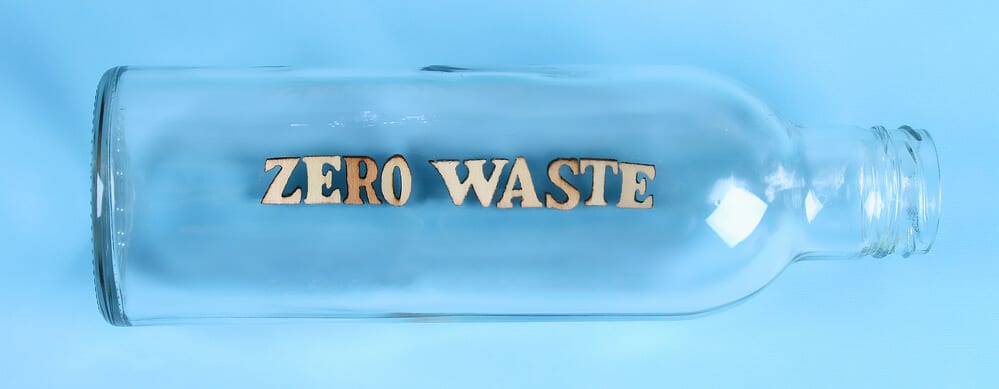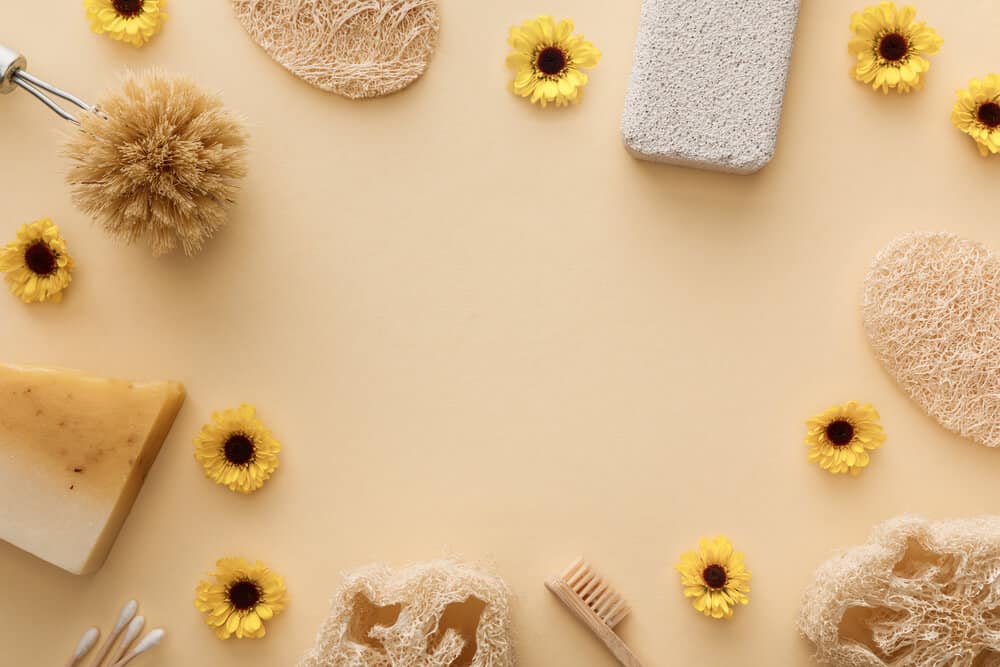Is it trash day again? It happens every week in American households.
Families fill up their plastic containers filled with plastic garbage bags of trash and wheel them to the curb. Did you know that, according to the EPA Environmental Protection Agency, Americans produced 4.9 pounds of trash every single day throughout 2018?
And, it seems to be getting worse.
So, turning to a Zero waste way of living inside our homes makes sense!
What if you could make a difference, starting in your home? You can have a Zero waste home.
Are you ready to cut down on waste one household at a time starting with your own? It’s easier than you might think.
It’s just going to take some focused choices.
What is Zero Waste?
Since you are reading this, chances are you are at least a bit curious as to how to cut down on your own personal waste.
Maybe you’ve been at it for quite some time and are looking to step it up. Or, maybe you’re simply curious to find out what it’s all about.
Zero Waste is essentially taking responsibility to conserve all resources through production, consumption, reuse, and recovery of all products, how products are packaged, and other materials without burning them, or discharging them to land, water, or air where it becomes a threat to human health.
It all starts with five basic steps to remember.
Here are some Zero waste tips for your home that start with five easy-to-remember words beginning with the letter “R”.
Surely, you’ve heard of the 3 R’s in education: Reading, wRiting, and aRithmetic!
In the 1970s, the Resource Conservation and Recovery Act tried to spread the message of environmental cleanup by taking on their own 3 R’s. Only their 3 R’s were, Reduce, Reuse, and Recycle.
While the ideas behind the clever 3 R’s slogans were genuine, they didn’t seem to be working.
Piles of trash continued to build up and even seemed to be getting worse.
That’s when a woman with insight stepped in to help promote and establish the idea of Zero Waste.
In 2013, an environmental activist came up with 5 R’s for achieving Zero home waste. They are:
- Refuse
- Reduce
- Reuse
- Recycle
- Rot
Refuse
It’s O.K. to say No! Refuse what you don’t need.
Don’t clutter up your home unnecessarily.
Refusing to buy or take into your house, to begin with, will do away with a lot of waste before it starts to accumulate.
Start by turning down free stuff that you don’t even need.
Think about it.
Do you really need that magnet or pad of paper and pen giveaway from the convention you last attended?
And, let’s not get started with all of the junk mail.
Refuse it before it even makes it to your mailbox by signing up for a free Catalog Choice service and by selecting digital copies of bills instead of the paper version.
But, possibly the worst culprit is the type of packaging you buy.
About 30 percent of American waste is made up of packaging and containers according to the EPA.
Some daily items to start refusing include:
- Single-use plastics, such as coffee or soda cups
- Plastic utensils
- Plastic straws
- Magazines, flyers, coupons
Get in the habit of using reusable cups, for instance.
Or, snap a picture of a coupon to use later instead of harboring a stack of newspapers for the sake of saving a dime.
If you start to refuse all things made of plastic, it will eventually drive down the demand.
Instead, start buying composted products to create consumer demand for alternative packaging.
Reduce
Can’t refuse it?
Reduce everything inside your home that you don’t need but can’t say no to.
Pay close attention to what you truly cannot live without, and only buy what you need.
When you do purchase a new item for your home, make sure it is quality over price.
In the long run, well-made items are going to last longer and save you money.
Avoid using disposable paper products or toxic Styrofoam.
If you absolutely have to have a disposable option for some reason, choose paper plates made out of certified compostable paper.
Reuse
If you cannot refuse it or reduce it, reuse it! Reuse everything at home that you consume.
Before you rush out to replace a broken item, first try to repair it.
Sometimes, you’re not even the one reusing the item.
Part of reusing could be donating something, so it gets a second chance at being used and not tossed into a landfill.
Before sending it to an anonymous charity, ask people you know if they need it.
If you don’t want to donate, sell your items online, or host a garage sale.
Likewise, when you need something, first see if a second-hand shop or garage sale has what you need.
- The idea of reusing items extends to education and entertainment as well when you use a library to borrow books and DVDs.
- Swap out disposables for reusables, such as shopping totes, refillable bottles, rags, cloth napkins.
- Buy items from bulk bins.
- Glass and stainless steel containers can be refilled again and again.
Recycle
OK, this one is probably the most obvious “R” of them all. But, whatever you can recycle, take the extra step to do so.
Though, even with recycling, there are issues and some practices that are not necessarily the best.
The way most households were used to recycling their items was turned upside down when China refused to take our waste in 2018.
Still, even with its flaws, it’s a good option to achieve Zero waste.
Make sure you properly clean and sort all recycled items.
Rot
The final “R” is to compost everything you can.
This starts in the kitchen of your home.
The EPA claims that more than 20 percent of landfills are comprised of food waste.
Instead of sending them to a landfill, get some great use out of them by composting your food scraps.
There are some great ways to compost even if you live in an apartment in a city or have limited land space or not enough time.
Vermiculture composting only requires a few items like a bin and some worms.

Common Misconceptions of Zero Waste Living In The Home
Living without waste doesn’t mean you hide away in a rock somewhere far, far away from civilization.
It also doesn’t mean giving up luxuries. It simply means making informed and conscious choices.
Benefits of Zero Waste Living At Home
Aside from the obvious environmental benefits and saving the landfills, living with Zero waste will save you money on unnecessary purchases as well as saving time and money.
Don’t be surprised if you see improvements to your health.
It Starts At Home!
Here are a few at-home tips to get you closer to Zero Waste in some key rooms inside the house:
In The Kitchen
- Get creative with leftovers, so you don’t have to toss them out.
- Donate cooking oil to be used for biodiesel fuel.
- Set up a composting station
- Swap out paper towels for reusable cloth
- Swap out sandwich bags for reusable containers
- Shop at farmer’s markets where you won’t have to peel off price stickers from our product. Bring a glass or reusable cloth containers, like a pillowcase for bread. Also, exchange your egg cartons or berry baskets while you’re there.
- Use a pressure cooker to save time and energy preparing meals.
Bathroom
Never have a toilet paper shortage when you use a washcloth.
But, if you’re not ready to take that major plunge into Zero waste living, at least buy 100% recycled and unbleached toilet paper.
Deodorant not only comes in a plastic container that adds to waste piling up, but it also usually contains dangerous aluminum.
Take care of both issues by swapping out your deodorant for baking soda or an alum stone.
Refill reusable containers with shampoo and conditioner bought in bulk.
If you’re ready to take another plunge into clean living, do without the conditioner.
Or, eliminate the shampoo too by going “no-poo” and using baking soda or vinegar. Or, use corn starch as a dry shampoo.
Swap out that fluoride toothpaste in a tube for baking soda instead.
When you brush, use a wooden compostable toothbrush.
While you run water waiting for your shower to heat up, collect the excess water in a bucket to use on your plants.
Cleaning and Laundry
- Fill a spray bottle with ½ cup of white distilled vinegar and 1 cup water. Add in about 15 drops of tea tree oil, lavender, eucalyptus, or lemon essential oil, and use as a multipurpose cleaner.
- Use Castile soap or other bulk liquid for dish or hand soap and for sinks and floors.
- Use vinegar to clean mildew.
- Use baking soda when you need extra scrubbing help.
- Use a stainless steel scourer and a wooden brush for scrubbing and rags for counters, floors, and mirrors.
- Use worn-out clothing cut up into rags for cleaning.
- Buy laundry and dishwasher detergent in bulk.
- Use chalk, vinegar, or lemon to get stains out.
- Dry clothing on a line whenever possible.
- Compost drier lint or any dust bunnies found around your home.
Take the First Step, Or Plunge In Even Deeper
Going for an absolutely complete Zero waste home starts with little steps and changes.
Maybe you’re already there and ready to dive into 100% Zero waste home life.
Use these helpful tips as your guide.


